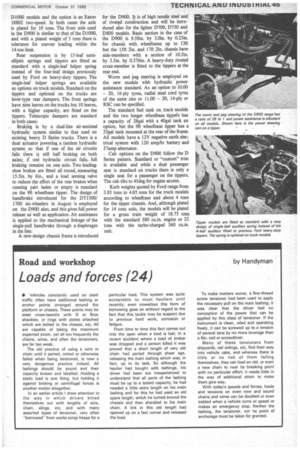Road and workshop by Handyman
Page 47

If you've noticed an error in this article please click here to report it so we can fix it.
Loads and forces (24)
• Vehicles constantly used on steel traffic often have additional lashing or anchor points arranged around the platform or chassis. These points may be steel cross-bearers with D or Bow shackles, or rings with plates attached which are bolted to the chassis, etc. All are capable of taking the maximum expected strain, yet all too frequently the chains, wires, and often the tensioners, are far too weak.
The old practice of using a wire or chain until it parted, rotted or otherwise failed when being tensioned, is now a very dangerous practice indeed. All lashings should be sound and their capacity known and labelled. Holding a static load is one thing, hut holding it against braking or centrifugal forces is another matter altogether.
In an earlier article I drew attention to the way in which drivers kitted themselves out with lengths of wire, chain, slings, etc, and with many assorted types of tensioner, very often "borrowed" from works scrap heaps for a particular load. This system was quite acceptable to most hauliers until recently; even nowadays this form of borrowing goes on without regard to the fact that this tackle may be suspect due to previous hard work, corrosion or fatigue.
From time to time this fact comes out into the open when a load is lost. In a recent accident where a load of timber was dropped and a person killed it was proved that a short length of very old chain had parted through sheer age, releasing the main lashing which was, in fact, up to its task. So although the haulier had bought safe lashings, his driver had been too inexperienced to understand that all parts of the lashing must be up to a tested capacity; he had needed a little extra length on his main lashing and for this he had used an old spare length, which he turned around the chassis and then shackled to his main chain. A link in this old length had opened up on a fast corner and released the load.
To make matters worse, a fine-thread screw tensioner had been used to apply the necessary pull on the main lashing; it was clear that the driver had no conception of the power that can be applied by this class of tensioner. If the instrument is clean, oiled and operating freely, it can be screwed up to a tension of several tons by no more leverage than a 6in. nail or screwdriver.
Many of these tensioners from shipyards, rail sidings, etc, find their way into vehicle cabs, and whereas there is little or no risk of them failing themselves, they can load an old, or even a new chain to near its breaking point with no particular effort; it needs little in the way of additional strain to make them give way.
With today's speeds and forces, loads and tensions on even new and sound chains and wires can be doubled or even trebled when a vehicle turns at speed or makes an emergency stop. Neither the lashing, the tensioner, nor its point of anchorage must be taken for granted.


























































































































